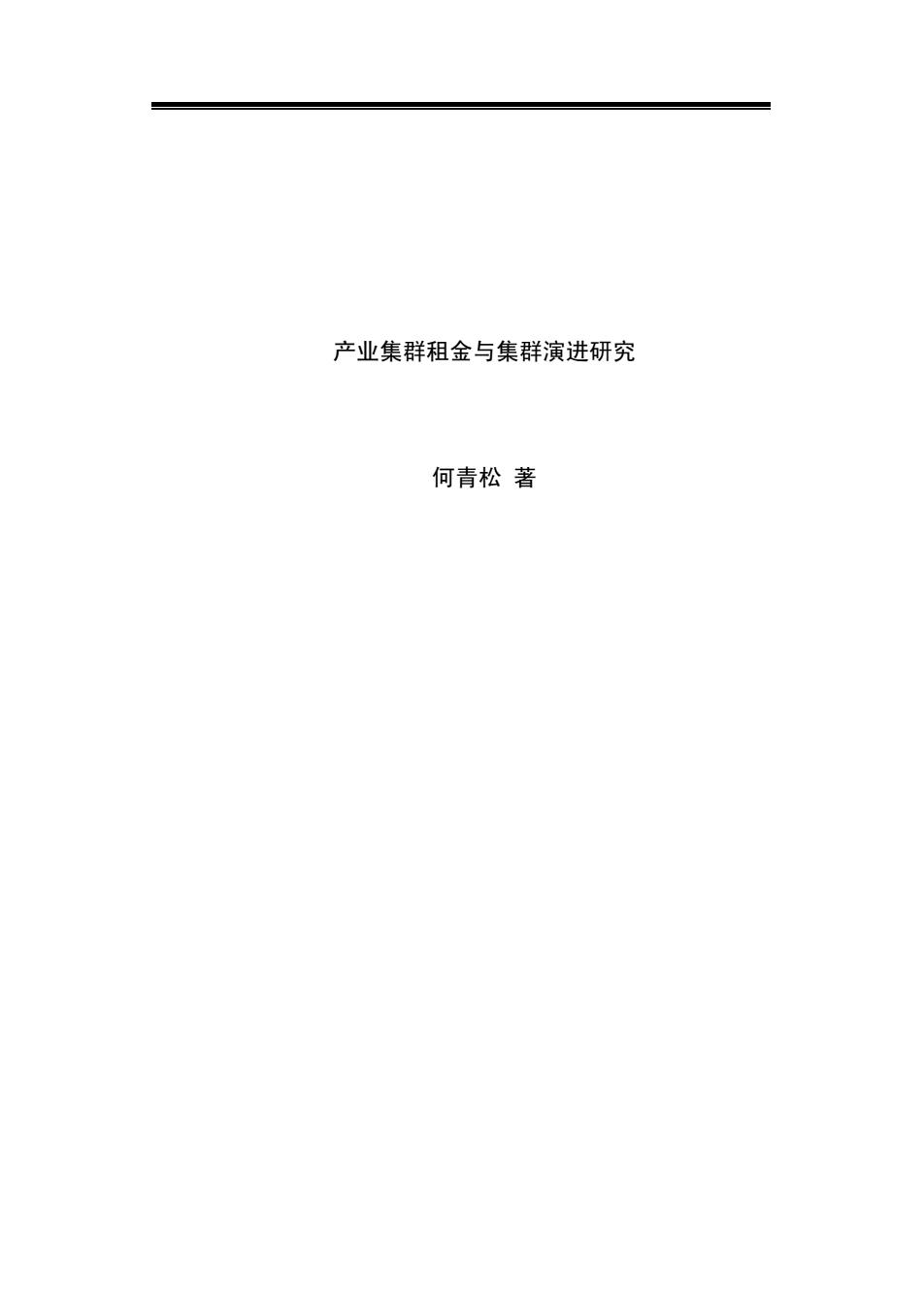
产业集群租金与集群演进研究 何青松著
产业集群租金与集群演进研究 何青松 著
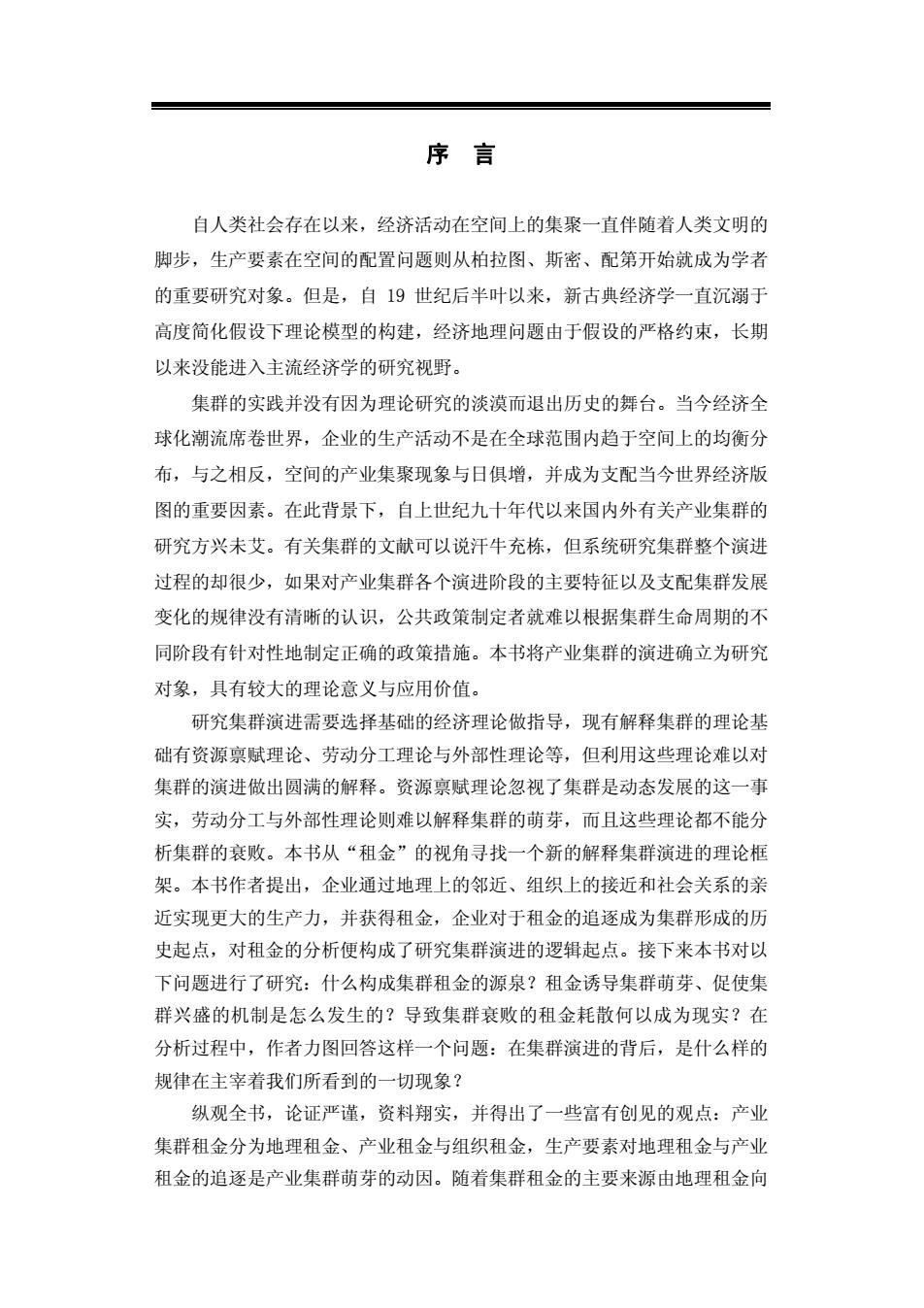
序言 自人类社会存在以来,经济活动在空间上的集聚一直伴随着人类文明的 脚步,生产要素在空间的配置问愿则从柏拉图、斯密、配第开始就成为学者 的重要研究对象。但是,自19世纪后半叶以来,新古典经济学一直沉溺于 高度简化假设下理论模型的构建,经济地理问题由于假设的严格约束,长期 以来没能进入主流经济学的研究视野。 集群的实践并没有因为理论研究的淡漠而退出历史的舞台。当今经济全 球化潮流席卷世界,企业的生产活动不是在全球范围内趋于空间上的均衡分 布,与之相反,空间的产业集聚现象与日俱增,并成为支配当今世界经济版 图的重要因素。在此背景下,自上世纪九十年代以来国内外有关产业集群的 研究方兴未艾。有关集群的文献可以说汗牛充栋,但系统研究集群整个演进 过程的却很少,如果对产业集群各个演进阶段的主要特征以及支配集群发展 变化的规律没有清晰的认识,公共政策制定者就难以根据集群生命周期的不 同阶段有针对性地制定正确的政策措施。本书将产业集群的演进确立为研究 对象,具有较大的理论意义与应用价值。 研究集群演进需要选择基础的经济理论做指导,现有解释集群的理论基 础有资源禀赋理论、劳动分工理论与外部性理论等,但利用这些理论难以对 集群的演进做出圆满的解释。资源禀赋理论忽视了集群是动态发展的这一事 实,劳动分工与外部性理论则难以解释集群的萌芽,而且这些理论都不能分 析集群的衰败。本书从“租金”的视角寻找一个新的解释集群演进的理论框 架。本书作者提出,企业通过地理上的邻近、组织上的接近和社会关系的亲 近实现更大的生产力,并获得租金,企业对于租金的追逐成为集群形成的历 史起点,对租金的分析便构成了研究集群演进的逻辑起点。接下来本书对以 下问题进行了研究:什么构成集群租金的源泉?租金诱导集群萌芽、促使集 群兴盛的机制是怎么发生的?导致集群衰败的租金耗散何以成为现实?在 分析过程中,作者力图回答这样一个问题:在集群演进的背后,是什么样的 规律在主幸着我们所看到的一切现象? 纵观全书,论证严谨,资料翔实,并得出了一些富有创见的观点:产业 集群租金分为地理租金、产业租金与组织租金,生产要素对地理租金与产业 租金的追逐是产业集群萌芽的动因。随着集群租金的主要来源由地理租金向
序 言 自人类社会存在以来,经济活动在空间上的集聚一直伴随着人类文明的 脚步,生产要素在空间的配置问题则从柏拉图、斯密、配第开始就成为学者 的重要研究对象。但是,自 19 世纪后半叶以来,新古典经济学一直沉溺于 高度简化假设下理论模型的构建,经济地理问题由于假设的严格约束,长期 以来没能进入主流经济学的研究视野。 集群的实践并没有因为理论研究的淡漠而退出历史的舞台。当今经济全 球化潮流席卷世界,企业的生产活动不是在全球范围内趋于空间上的均衡分 布,与之相反,空间的产业集聚现象与日俱增,并成为支配当今世界经济版 图的重要因素。在此背景下,自上世纪九十年代以来国内外有关产业集群的 研究方兴未艾。有关集群的文献可以说汗牛充栋,但系统研究集群整个演进 过程的却很少,如果对产业集群各个演进阶段的主要特征以及支配集群发展 变化的规律没有清晰的认识,公共政策制定者就难以根据集群生命周期的不 同阶段有针对性地制定正确的政策措施。本书将产业集群的演进确立为研究 对象,具有较大的理论意义与应用价值。 研究集群演进需要选择基础的经济理论做指导,现有解释集群的理论基 础有资源禀赋理论、劳动分工理论与外部性理论等,但利用这些理论难以对 集群的演进做出圆满的解释。资源禀赋理论忽视了集群是动态发展的这一事 实,劳动分工与外部性理论则难以解释集群的萌芽,而且这些理论都不能分 析集群的衰败。本书从“租金”的视角寻找一个新的解释集群演进的理论框 架。本书作者提出,企业通过地理上的邻近、组织上的接近和社会关系的亲 近实现更大的生产力,并获得租金,企业对于租金的追逐成为集群形成的历 史起点,对租金的分析便构成了研究集群演进的逻辑起点。接下来本书对以 下问题进行了研究:什么构成集群租金的源泉?租金诱导集群萌芽、促使集 群兴盛的机制是怎么发生的?导致集群衰败的租金耗散何以成为现实?在 分析过程中,作者力图回答这样一个问题:在集群演进的背后,是什么样的 规律在主宰着我们所看到的一切现象? 纵观全书,论证严谨,资料翔实,并得出了一些富有创见的观点:产业 集群租金分为地理租金、产业租金与组织租金,生产要素对地理租金与产业 租金的追逐是产业集群萌芽的动因。随着集群租金的主要来源由地理租金向
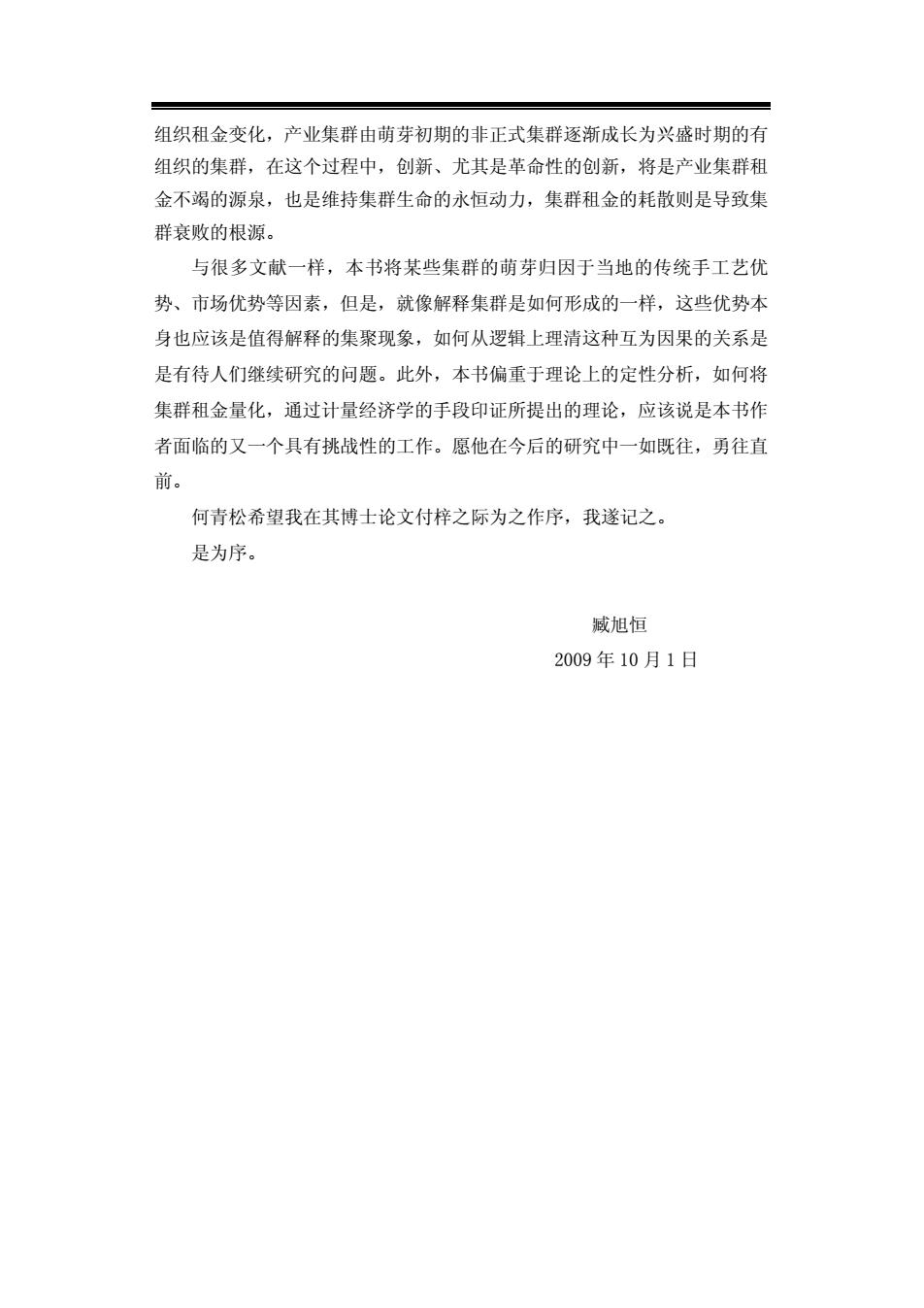
组织租金变化,产业集群由萌芽初期的非正式集群逐渐成长为兴盛时期的有 组织的集群,在这个过程中,创新、尤其是革命性的创新,将是产业集群租 金不竭的源泉,也是维持集群生命的永恒动力,集群租金的耗散则是导致集 群衰败的根源。 与很多文献一样,本书将某些集群的萌芽归因于当地的传统手工艺优 势、市场优势等因素,但是,就像解释集群是如何形成的一样,这些优势本 身也应该是值得解释的集聚现象,如何从逻辑上理清这种互为因果的关系是 是有待人们继续研究的问题。此外,本书偏重于理论上的定性分析,如何将 集群租金量化,通过计量经济学的手段印证所提出的理论,应该说是本书作 者面临的又一个具有挑战性的工作。愿他在今后的研究中一如既往,勇往直 前。 何青松希望我在其博士论文付梓之际为之作序,我遂记之。 是为序。 臧旭恒 2009年10月1日
组织租金变化,产业集群由萌芽初期的非正式集群逐渐成长为兴盛时期的有 组织的集群,在这个过程中,创新、尤其是革命性的创新,将是产业集群租 金不竭的源泉,也是维持集群生命的永恒动力,集群租金的耗散则是导致集 群衰败的根源。 与很多文献一样,本书将某些集群的萌芽归因于当地的传统手工艺优 势、市场优势等因素,但是,就像解释集群是如何形成的一样,这些优势本 身也应该是值得解释的集聚现象,如何从逻辑上理清这种互为因果的关系是 是有待人们继续研究的问题。此外,本书偏重于理论上的定性分析,如何将 集群租金量化,通过计量经济学的手段印证所提出的理论,应该说是本书作 者面临的又一个具有挑战性的工作。愿他在今后的研究中一如既往,勇往直 前。 何青松希望我在其博士论文付梓之际为之作序,我遂记之。 是为序。 臧旭恒 2009 年 10 月 1 日

前言 近年来,产业集群问题引发了学者、政府官员、企业家的广泛关注。大 量集群不断涌现、壮大,成为发展区域经济、提高区域竞争力的有效经济组 织形式,也有一些集群却走上了衰败的道路,如何把握集群演进的规律,这 是一个具有理论意义与应用价值的话题。 “产业集群租金”是本书研究的首要概念工具。本书在回顾古典租金理 论,并总结租金理论新的发展的基础上,提出了“产业集群租金”的概念, 并由此衍生出三个子概念:地理租金、产业租金与组织租金。以产业集群租 金为主线,本书首先分析了集群租金的来源,然后从地理租金、产业租金与 组织租金三个维度,按集群生命周期所经历的萌芽、兴盛与衰败三个阶段, 依次对产业集群的演进展开研究,就集群演进各个阶段与地理租金、产业租 金与组织租金之间的关系,得出以下一般性规律: 1)生产要素对产业集群租金的追逐是产业集群萌芽的动因。生产要素 可以通过地理上的邻近、组织上的接近和社会关系的亲近来实现更大的生产 力,借助于产业集群获取租金。其中地理租金金往往是当地自然资源优势、 优良的文化习俗、悠久的传统工艺、信息技术外溢以及政府推动等因素影响 的结果,当生产要素在该地区能够或者预期能够获得地理租金时,集聚就会 发生,产业集群萌芽由此而生。 产业集群一方面可以通过生产要素在空间的自由流动集聚而成,另一方 面,也可能是空间粘滞性要素在追求产业租金的动力下,由低利润产业向高 利润产业转移,在当地形成产业集群。显然,如果产业集群是由区域外流入 的要素和区域内生产要素共同集聚的结果,无疑其形成过程会加速。所以, 降低市场进入壁垒和地区市场分割,减少地方本位主义不适当的行政干预, 可以促进集群的成长。 2)随着集群租金主要来源由地理租金或产业租金向组织租金变化,产 业集群由萌芽初期的非正式集群逐渐成长为兴盛时期的有组织的集群,而后 者要比前者复杂和先进得多。在非正式集群中,企业仅仅是简单、被动地集 中在一起,它们只能由于地理邻近而获得外部经济,在有组织的产业集群中, 由于存在分工合作网络与集体协调行动,因此,有利于克服众多相互分散
前 言 近年来,产业集群问题引发了学者、政府官员、企业家的广泛关注。大 量集群不断涌现、壮大,成为发展区域经济、提高区域竞争力的有效经济组 织形式,也有一些集群却走上了衰败的道路,如何把握集群演进的规律,这 是一个具有理论意义与应用价值的话题。 “产业集群租金”是本书研究的首要概念工具。本书在回顾古典租金理 论,并总结租金理论新的发展的基础上,提出了“产业集群租金”的概念, 并由此衍生出三个子概念:地理租金、产业租金与组织租金。以产业集群租 金为主线,本书首先分析了集群租金的来源,然后从地理租金、产业租金与 组织租金三个维度,按集群生命周期所经历的萌芽、兴盛与衰败三个阶段, 依次对产业集群的演进展开研究,就集群演进各个阶段与地理租金、产业租 金与组织租金之间的关系,得出以下一般性规律: 1)生产要素对产业集群租金的追逐是产业集群萌芽的动因。生产要素 可以通过地理上的邻近、组织上的接近和社会关系的亲近来实现更大的生产 力,借助于产业集群获取租金。其中地理租金金往往是当地自然资源优势、 优良的文化习俗、悠久的传统工艺、信息技术外溢以及政府推动等因素影响 的结果,当生产要素在该地区能够或者预期能够获得地理租金时,集聚就会 发生,产业集群萌芽由此而生。 产业集群一方面可以通过生产要素在空间的自由流动集聚而成,另一方 面,也可能是空间粘滞性要素在追求产业租金的动力下,由低利润产业向高 利润产业转移,在当地形成产业集群。显然,如果产业集群是由区域外流入 的要素和区域内生产要素共同集聚的结果,无疑其形成过程会加速。所以, 降低市场进入壁垒和地区市场分割,减少地方本位主义不适当的行政干预, 可以促进集群的成长。 2)随着集群租金主要来源由地理租金或产业租金向组织租金变化,产 业集群由萌芽初期的非正式集群逐渐成长为兴盛时期的有组织的集群,而后 者要比前者复杂和先进得多。在非正式集群中,企业仅仅是简单、被动地集 中在一起,它们只能由于地理邻近而获得外部经济,在有组织的产业集群中, 由于存在分工合作网络与集体协调行动,因此,有利于克服众多相互分散
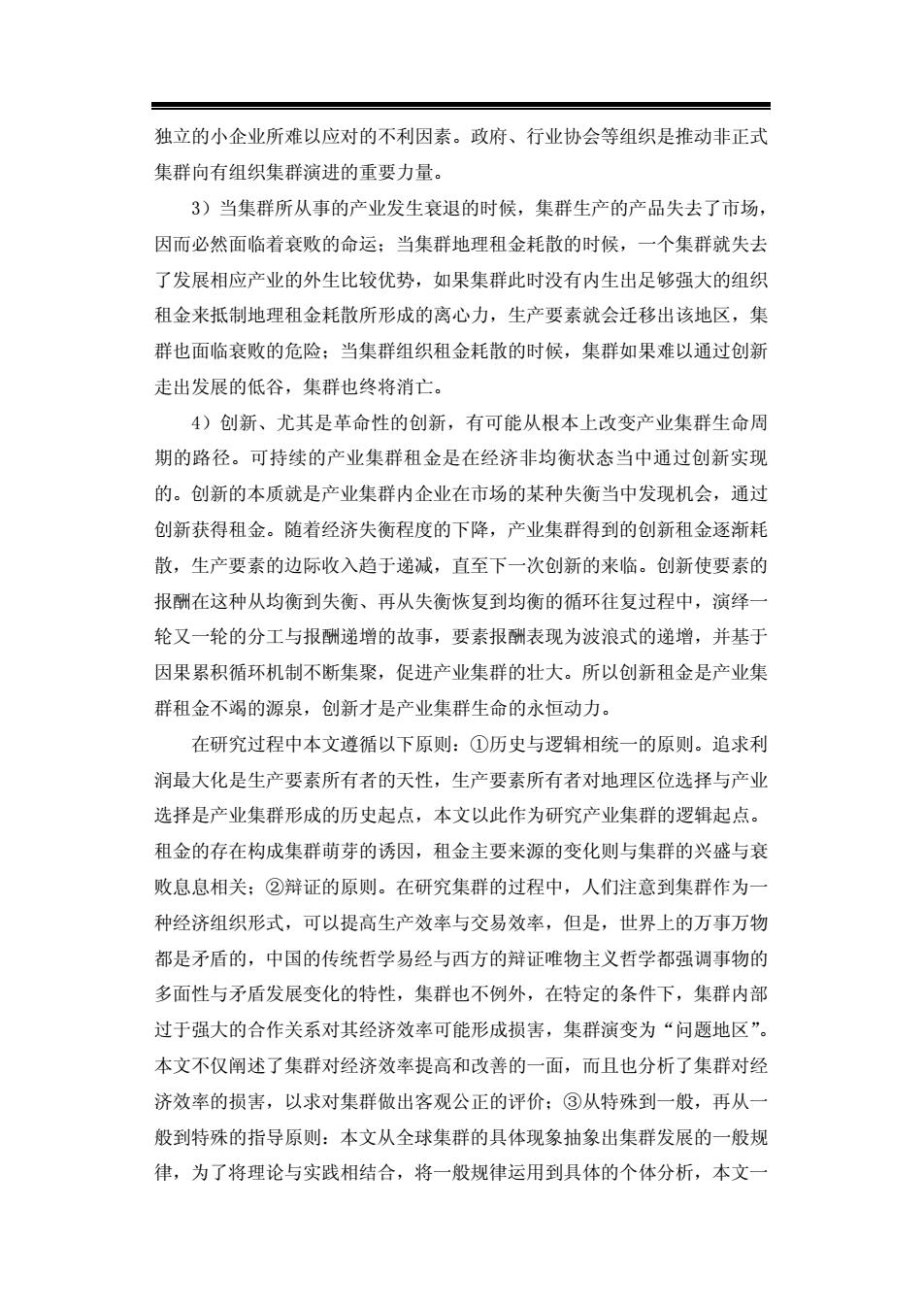
独立的小企业所难以应对的不利因素。政府、行业协会等组织是推动非正式 集群向有组织集群演进的重要力量。 3)当集群所从事的产业发生衰退的时候,集群生产的产品失去了市场, 因而必然面临者衰败的命运:当集群地理租金耗散的时候,一个集群就失去 了发展相应产业的外生比较优势,如果集群此时没有内生出足够强大的组织 租金来抵制地理租金耗散所形成的离心力,生产要素就会迁移出该地区,集 群也面临衰败的危险:当集群组织租金耗散的时候,集群如果难以通过创新 走出发展的低谷,集群也终将消亡。 4)创新、尤其是革命性的创新,有可能从根本上改变产业集群生命周 期的路径。可持续的产业集群租金是在经济非均衡状态当中通过创新实现 的。创新的本质就是产业集群内企业在市场的某种失衡当中发现机会,通过 创新获得租金。随着经济失衡程度的下降,产业集群得到的创新租金逐渐耗 散,生产要素的边际收入趋于递减,直至下一次创新的来临。创新使要素的 报酬在这种从均衡到失衡、再从失衡恢复到均衡的循环往复过程中,演绎 轮又一轮的分工与报酬递增的故事,要素报酬表现为波浪式的递增,并基于 因果累积循环机制不断集聚,促进产业集群的壮大。所以创新租金是产业集 群租金不竭的源泉,创新才是产业集群生命的永恒动力。 在研究过程中本文遵循以下原则:①历史与逻辑相统一的原则。追求利 润最大化是生产要素所有者的天性,生产要素所有者对地理区位选择与产业 选择是产业集群形成的历史起点,本文以此作为研究产业集群的逻辑起点。 租金的存在构成集群萌芽的诱因,租金主要来源的变化则与集群的兴盛与衰 败息息相关:②辩证的原则。在研究集群的过程中,人们注意到集群作为一 种经济组织形式,可以提高生产效率与交易效率,但是,世界上的万事万物 都是矛盾的,中国的传统哲学易经与西方的辩证唯物主义哲学都强调事物的 多面性与矛盾发展变化的特性,集群也不例外,在特定的条件下,集群内部 过于强大的合作关系对其经济效率可能形成损害,集群演变为“问题地区”。 本文不仅阐述了集群对经济效率提高和改善的一面,而且也分析了集群对经 济效率的损害,以求对集群做出客观公正的评价:③从特殊到一般,再从一 般到特殊的指导原则:本文从全球集群的具体现象抽象出集群发展的一般规 律,为了将理论与实践相结合,将一般规律运用到具体的个体分析,本文
独立的小企业所难以应对的不利因素。政府、行业协会等组织是推动非正式 集群向有组织集群演进的重要力量。 3)当集群所从事的产业发生衰退的时候,集群生产的产品失去了市场, 因而必然面临着衰败的命运;当集群地理租金耗散的时候,一个集群就失去 了发展相应产业的外生比较优势,如果集群此时没有内生出足够强大的组织 租金来抵制地理租金耗散所形成的离心力,生产要素就会迁移出该地区,集 群也面临衰败的危险;当集群组织租金耗散的时候,集群如果难以通过创新 走出发展的低谷,集群也终将消亡。 4)创新、尤其是革命性的创新,有可能从根本上改变产业集群生命周 期的路径。可持续的产业集群租金是在经济非均衡状态当中通过创新实现 的。创新的本质就是产业集群内企业在市场的某种失衡当中发现机会,通过 创新获得租金。随着经济失衡程度的下降,产业集群得到的创新租金逐渐耗 散,生产要素的边际收入趋于递减,直至下一次创新的来临。创新使要素的 报酬在这种从均衡到失衡、再从失衡恢复到均衡的循环往复过程中,演绎一 轮又一轮的分工与报酬递增的故事,要素报酬表现为波浪式的递增,并基于 因果累积循环机制不断集聚,促进产业集群的壮大。所以创新租金是产业集 群租金不竭的源泉,创新才是产业集群生命的永恒动力。 在研究过程中本文遵循以下原则:①历史与逻辑相统一的原则。追求利 润最大化是生产要素所有者的天性,生产要素所有者对地理区位选择与产业 选择是产业集群形成的历史起点,本文以此作为研究产业集群的逻辑起点。 租金的存在构成集群萌芽的诱因,租金主要来源的变化则与集群的兴盛与衰 败息息相关;②辩证的原则。在研究集群的过程中,人们注意到集群作为一 种经济组织形式,可以提高生产效率与交易效率,但是,世界上的万事万物 都是矛盾的,中国的传统哲学易经与西方的辩证唯物主义哲学都强调事物的 多面性与矛盾发展变化的特性,集群也不例外,在特定的条件下,集群内部 过于强大的合作关系对其经济效率可能形成损害,集群演变为“问题地区”。 本文不仅阐述了集群对经济效率提高和改善的一面,而且也分析了集群对经 济效率的损害,以求对集群做出客观公正的评价;③从特殊到一般,再从一 般到特殊的指导原则:本文从全球集群的具体现象抽象出集群发展的一般规 律,为了将理论与实践相结合,将一般规律运用到具体的个体分析,本文一
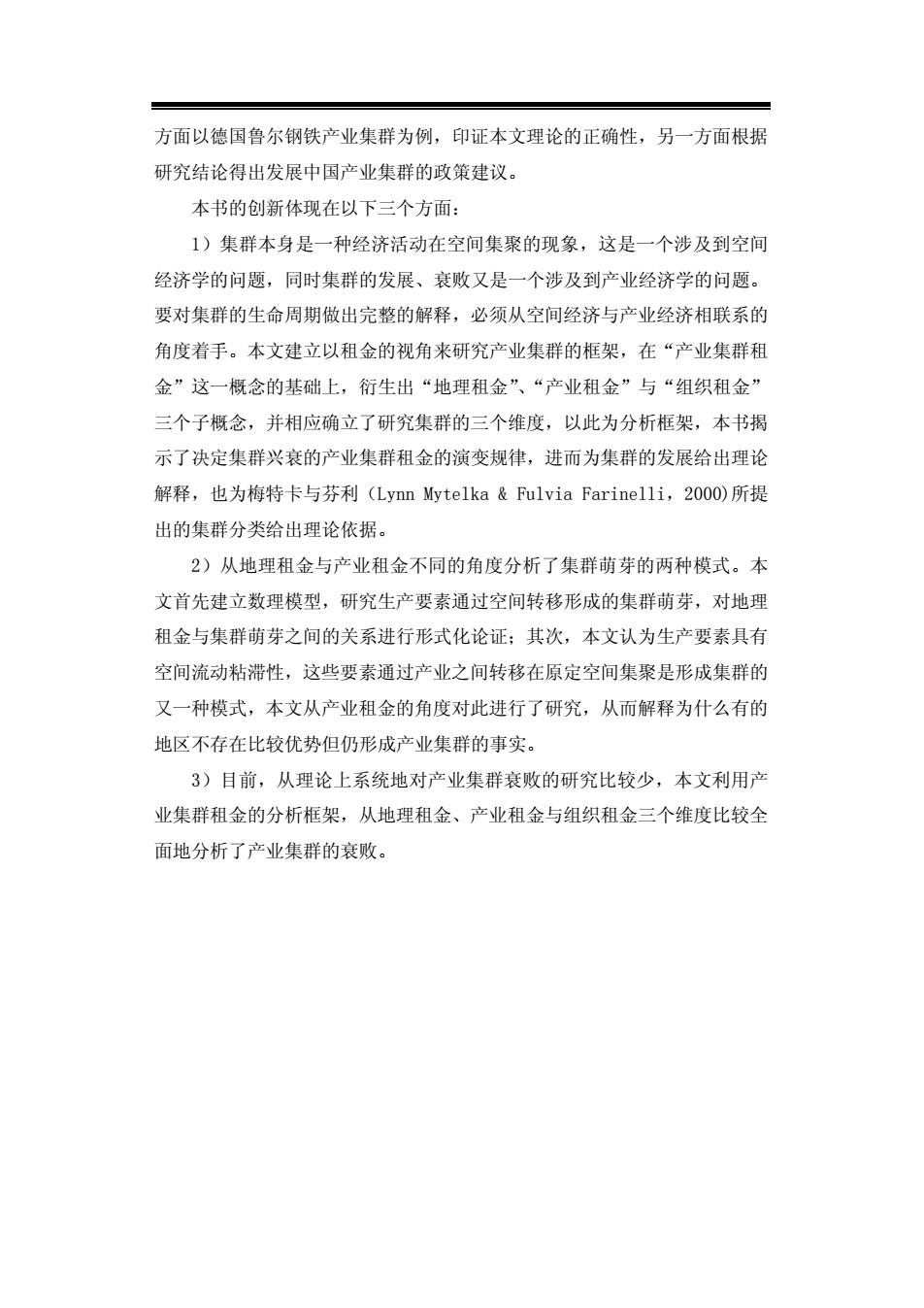
方面以德国鲁尔钢铁产业集群为例,印证本文理论的正确性,另一方面根据 研究结论得出发展中国产业集群的政策建议。 本书的创新体现在以下三个方面: 1)集群本身是一种经济活动在空间集聚的现象,这是一个涉及到空间 经济学的问题,同时集群的发展、衰败又是一个涉及到产业经济学的问题。 要对集群的生命周期做出完整的解释,必须从空间经济与产业经济相联系的 角度着手。本文建立以租金的视角来研究产业集群的框架,在“产业集群租 金”这一概念的基础上,衍生出“地理租金”、“产业租金”与“组织租金” 三个子概念,并相应确立了研究集群的三个维度,以此为分析框架,本书揭 示了决定集群兴衰的产业集群租金的演变规律,进而为集群的发展给出理论 解释,也为梅特卡与芬利(Lynn Mytelka&Fulvia Farinelli,200o)所提 出的集群分类给出理论依据。 2)从地理租金与产业租金不同的角度分析了集群萌芽的两种模式。本 文首先建立数理模型,研究生产要素通过空间转移形成的集群萌芽,对地理 租金与集群萌芽之间的关系进行形式化论证:其次,本文认为生产要素具有 空间流动粘滞性,这些要素通过产业之间转移在原定空间集聚是形成集群的 又一种模式,本文从产业租金的角度对此进行了研究,从而解释为什么有的 地区不存在比较优势但仍形成产业集群的事实。 3)目前,从理论上系统地对产业集群衰败的研究比较少,本文利用产 业集群租金的分析框架,从地理租金、产业租金与组织租金三个维度比较全 面地分析了产业集群的衰败
方面以德国鲁尔钢铁产业集群为例,印证本文理论的正确性,另一方面根据 研究结论得出发展中国产业集群的政策建议。 本书的创新体现在以下三个方面: 1)集群本身是一种经济活动在空间集聚的现象,这是一个涉及到空间 经济学的问题,同时集群的发展、衰败又是一个涉及到产业经济学的问题。 要对集群的生命周期做出完整的解释,必须从空间经济与产业经济相联系的 角度着手。本文建立以租金的视角来研究产业集群的框架,在“产业集群租 金”这一概念的基础上,衍生出“地理租金”、“产业租金”与“组织租金” 三个子概念,并相应确立了研究集群的三个维度,以此为分析框架,本书揭 示了决定集群兴衰的产业集群租金的演变规律,进而为集群的发展给出理论 解释,也为梅特卡与芬利(Lynn Mytelka & Fulvia Farinelli,2000)所提 出的集群分类给出理论依据。 2)从地理租金与产业租金不同的角度分析了集群萌芽的两种模式。本 文首先建立数理模型,研究生产要素通过空间转移形成的集群萌芽,对地理 租金与集群萌芽之间的关系进行形式化论证;其次,本文认为生产要素具有 空间流动粘滞性,这些要素通过产业之间转移在原定空间集聚是形成集群的 又一种模式,本文从产业租金的角度对此进行了研究,从而解释为什么有的 地区不存在比较优势但仍形成产业集群的事实。 3)目前,从理论上系统地对产业集群衰败的研究比较少,本文利用产 业集群租金的分析框架,从地理租金、产业租金与组织租金三个维度比较全 面地分析了产业集群的衰败
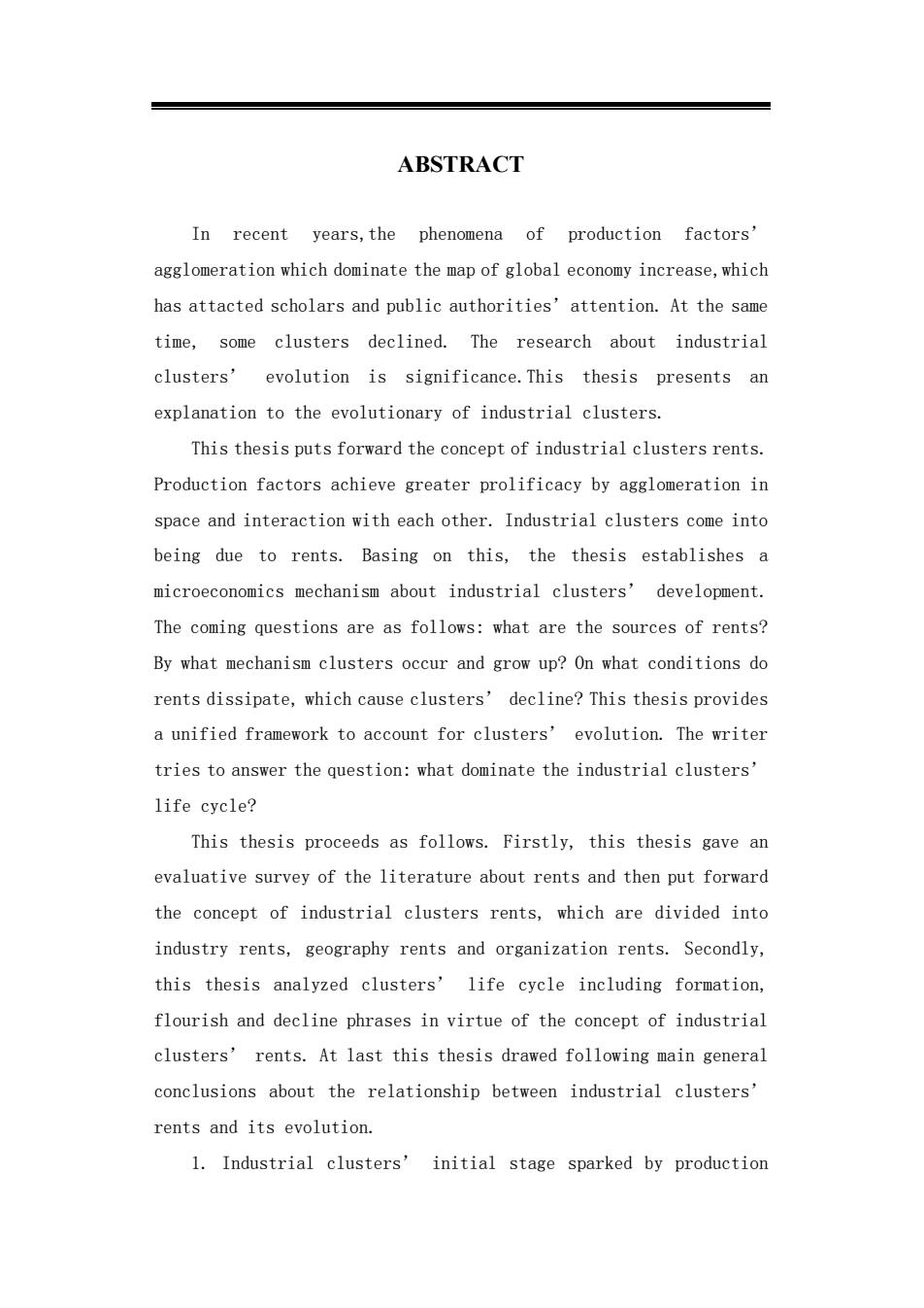
ABSTRACT In recent years,the phenomena of production factors' agglomeration which dominate the map of global economy increase,which has attacted scholars and public authorities'attention.At the same time,some clusters declined.The research about industrial clusters'evolution is significance.This thesis presents an explanation to the evolutionary of industrial clusters. This thesis puts forward the concept of industrial clusters rents. Production factors achieve greater prolificacy by agglomeration in space and interaction with each other.Industrial clusters come into being due to rents.Basing on this,the thesis establishes a microeconomics mechanism about industrial clusters'development. The coming questions are as follows:what are the sources of rents? By what mechanism clusters occur and grow up?On what conditions do rents dissipate,which cause clusters'decline?This thesis provides a unified framework to account for clusters'evolution.The writer tries to answer the question:what dominate the industrial clusters' life cycle? This thesis proceeds as follows.Firstly,this thesis gave an evaluative survey of the literature about rents and then put forward the concept of industrial clusters rents,which are divided into industry rents,geography rents and organization rents.Secondly, this thesis analyzed clusters'life cycle including formation, flourish and decline phrases in virtue of the concept of industrial clusters'rents.At last this thesis drawed following main general conclusions about the relationship between industrial clusters' rents and its evolution. 1.Industrial clusters'initial stage sparked by production
ABSTRACT In recent years,the phenomena of production factors’ agglomeration which dominate the map of global economy increase,which has attacted scholars and public authorities’attention. At the same time, some clusters declined. The research about industrial clusters’ evolution is significance.This thesis presents an explanation to the evolutionary of industrial clusters. This thesis puts forward the concept of industrial clusters rents. Production factors achieve greater prolificacy by agglomeration in space and interaction with each other. Industrial clusters come into being due to rents. Basing on this, the thesis establishes a microeconomics mechanism about industrial clusters’ development. The coming questions are as follows: what are the sources of rents? By what mechanism clusters occur and grow up? On what conditions do rents dissipate, which cause clusters’ decline? This thesis provides a unified framework to account for clusters’ evolution. The writer tries to answer the question: what dominate the industrial clusters’ life cycle? This thesis proceeds as follows. Firstly, this thesis gave an evaluative survey of the literature about rents and then put forward the concept of industrial clusters rents, which are divided into industry rents, geography rents and organization rents. Secondly, this thesis analyzed clusters’ life cycle including formation, flourish and decline phrases in virtue of the concept of industrial clusters’ rents. At last this thesis drawed following main general conclusions about the relationship between industrial clusters’ rents and its evolution. 1. Industrial clusters’ initial stage sparked by production

factors'chasing for industrial clusters rents.Firms achieve greater prolificacy by agglomeration in space,cooperation with each other and proximity of social relationship.Therefore enterprises in clusters can yield much more rents.Geography rents yield by resource advantage,favorable culture and historical circumstances, traditional craft,information and knowledge diffusion,plausible policies by government in local region,so industrial clusters come into being due to geography rents.Besides this,clusters may form when some sticky production factors in space transfer from low-profit industries to high-profit industries.Obviously,the formation of clusters will be spurred if production factors both inside and outside the region concentrate in one area.Therefore,we can promote industrial clusters'development by eliminating market entrance barrier,carrying out trade liberation policy and avoiding government irrelevant intervention. 2.As the main sources of industrial clusters rents turn to the organization rents from the industry rents and geography rents,the industrial clusters evolve from the informal industrial clusters to the organized industrial clusters,the later ones are more complicated and advanced.In the informal clusters,enterprises agglomerate in space to gain external economies passively.In the formal clusters, enterprises cooperate and harmonize with each others,therefore overcome many disadvantages that independent small enterprises cann't get over.The government and industrial institute play important rule in this stage. 3.When industries experience downthrown demand in the market, clusters decline spontaneously.Industrial clusters will lose exogenous comparative advantages due to dissipation of geography rents.If clusters can't yield organization rents endogenous to resist centrifugal forces,the industrial cluster will decline
factors’ chasing for industrial clusters rents. Firms achieve greater prolificacy by agglomeration in space, cooperation with each other and proximity of social relationship. Therefore enterprises in clusters can yield much more rents. Geography rents yield by resource advantage, favorable culture and historical circumstances, traditional craft, information and knowledge diffusion, plausible policies by government in local region, so industrial clusters come into being due to geography rents. Besides this, clusters may form when some sticky production factors in space transfer from low-profit industries to high-profit industries. Obviously, the formation of clusters will be spurred if production factors both inside and outside the region concentrate in one area. Therefore, we can promote industrial clusters’ development by eliminating market entrance barrier, carrying out trade liberation policy and avoiding government irrelevant intervention. 2. As the main sources of industrial clusters rents turn to the organization rents from the industry rents and geography rents, the industrial clusters evolve from the informal industrial clusters to the organized industrial clusters, the later ones are more complicated and advanced. In the informal clusters, enterprises agglomerate in space to gain external economies passively. In the formal clusters, enterprises cooperate and harmonize with each others, therefore overcome many disadvantages that independent small enterprises cann’t get over. The government and industrial institute play important rule in this stage. 3. When industries experience downthrown demand in the market, clusters decline spontaneously. Industrial clusters will lose exogenous comparative advantages due to dissipation of geography rents. If clusters can’t yield organization rents endogenous to resist centrifugal forces, the industrial cluster will decline

Furthermore,clusters face the fate of decay when there are no enough innovations. 4.Innovation,especially revolutionary innovation,may change clusters'developing route.Sustainable industrial clusters rents are yielded by innovation.The essence of innovation is yield rents when enterprises in clusters grasp profit-gained chances when economy is in the process of adjustment.When the extent of disequilibrium in economy reduces,innovation rents dissipate gradually.Marginal returns diminish until next innovation come into being.When economy swings between equilibrium and disequilibrium it is innovation by which production factors yield increasing returns by mechanism of positive feedback.So innovation rents are sustainable source of industrial clusters rents,and innovation is everlasting impetus for clusters. The main research methods adopted in this thesis are as follows: 1.Unification of history and logic approach.The aim of production factors is maximizing their profit.Their choices of location and industries lead to the origin of clusters,and this is the logic start-up of this research.This thesis holds that the industrial clusters come into being due to the industrial clusters rents.The change of industrial clusters rents'main source is closely linked with clusters'development. 2.Dialectic approach.Being one kind of economic organization, cluster can improve economic efficiency.But everything is paradoxical.Chinese traditional philosophy and western dialectician both emphasize the law of contradiction.Under certain conditions too strong cooperation relationship in clusters may damage the economic efficiency of inter-firm network,even lead clusters to "problem areas".To appraise industrial clusters objectively,this thesis analyzes systematically the damage of clusters to regional economy
Furthermore, clusters face the fate of decay when there are no enough innovations. 4. Innovation, especially revolutionary innovation, may change clusters’ developing route. Sustainable industrial clusters rents are yielded by innovation. The essence of innovation is yield rents when enterprises in clusters grasp profit-gained chances when economy is in the process of adjustment. When the extent of disequilibrium in economy reduces, innovation rents dissipate gradually. Marginal returns diminish until next innovation come into being. When economy swings between equilibrium and disequilibrium it is innovation by which production factors yield increasing returns by mechanism of positive feedback. So innovation rents are sustainable source of industrial clusters rents, and innovation is everlasting impetus for clusters. The main research methods adopted in this thesis are as follows: 1. Unification of history and logic approach. The aim of production factors is maximizing their profit. Their choices of location and industries lead to the origin of clusters, and this is the logic start-up of this research. This thesis holds that the industrial clusters come into being due to the industrial clusters rents. The change of industrial clusters rents’ main source is closely linked with clusters’ development. 2. Dialectic approach. Being one kind of economic organization, cluster can improve economic efficiency. But everything is paradoxical. Chinese traditional philosophy and western dialectician both emphasize the law of contradiction. Under certain conditions too strong cooperation relationship in clusters may damage the economic efficiency of inter-firm network, even lead clusters to “problem areas”. To appraise industrial clusters objectively, this thesis analyzes systematically the damage of clusters to regional economy
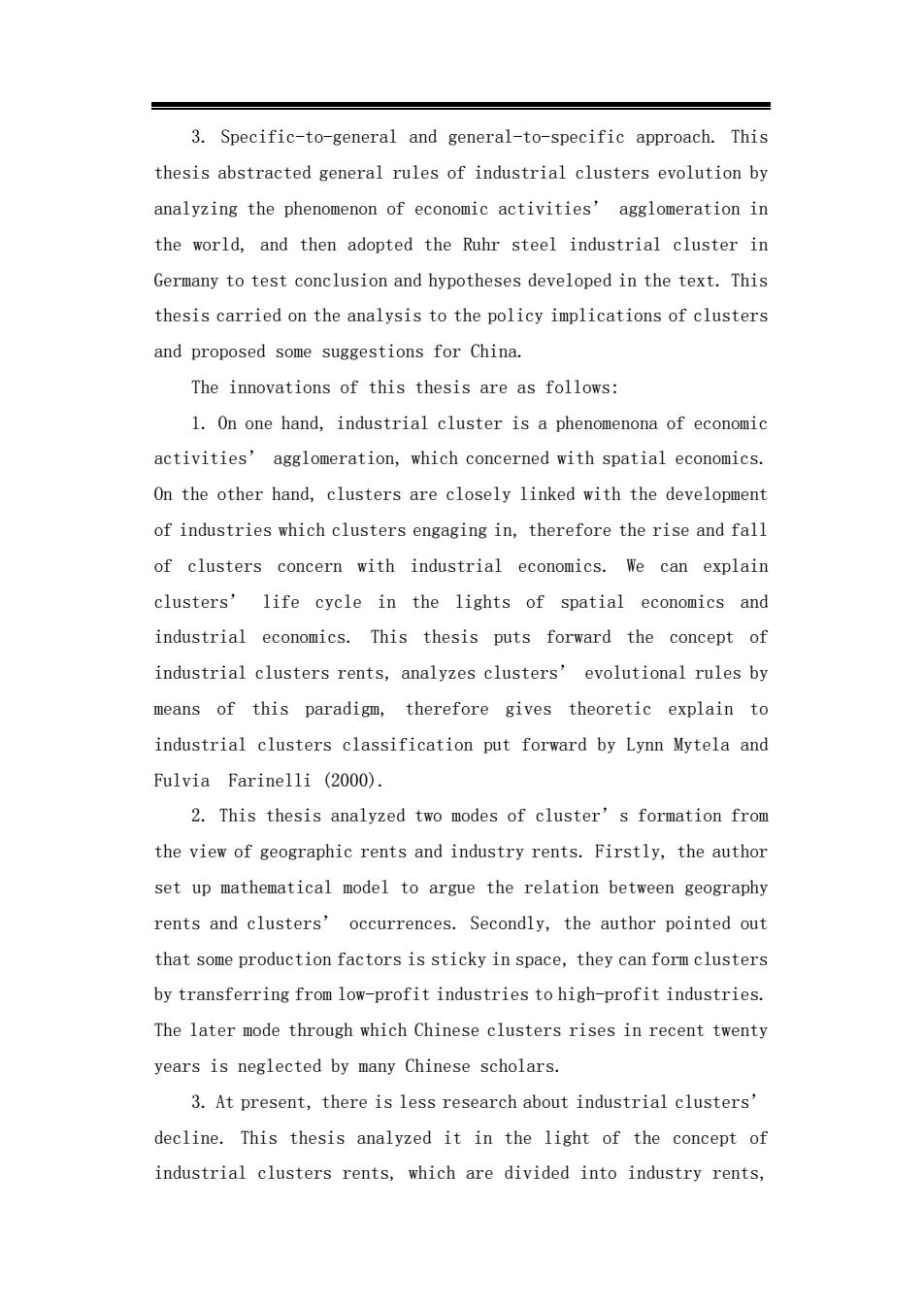
3.Specific-to-general and general-to-specific approach.This thesis abstracted general rules of industrial clusters evolution by analyzing the phenomenon of economic activities'agglomeration in the world,and then adopted the Ruhr steel industrial cluster in Germany to test conclusion and hypotheses developed in the text.This thesis carried on the analysis to the policy implications of clusters and proposed some suggestions for China. The innovations of this thesis are as follows: 1.On one hand,industrial cluster is a phenomenona of economic activities'agglomeration,which concerned with spatial economics. On the other hand,clusters are closely linked with the development of industries which clusters engaging in,therefore the rise and fall of clusters concern with industrial economics.We can explain clusters'life cycle in the lights of spatial economics and industrial economics.This thesis puts forward the concept of industrial clusters rents,analyzes clusters'evolutional rules by means of this paradigm,therefore gives theoretic explain to industrial clusters classification put forward by Lynn Mytela and Fulvia Farinelli (2000). 2.This thesis analyzed two modes of cluster's formation from the view of geographic rents and industry rents.Firstly,the author set up mathematical model to argue the relation between geography rents and clusters'occurrences.Secondly,the author pointed out that some production factors is sticky in space,they can form clusters by transferring from low-profit industries to high-profit industries. The later mode through which Chinese clusters rises in recent twenty years is neglected by many Chinese scholars. 3.At present,there is less research about industrial clusters' decline.This thesis analyzed it in the light of the concept of industrial clusters rents,which are divided into industry rents
3. Specific-to-general and general-to-specific approach. This thesis abstracted general rules of industrial clusters evolution by analyzing the phenomenon of economic activities’ agglomeration in the world, and then adopted the Ruhr steel industrial cluster in Germany to test conclusion and hypotheses developed in the text. This thesis carried on the analysis to the policy implications of clusters and proposed some suggestions for China. The innovations of this thesis are as follows: 1. On one hand, industrial cluster is a phenomenona of economic activities’ agglomeration, which concerned with spatial economics. On the other hand, clusters are closely linked with the development of industries which clusters engaging in, therefore the rise and fall of clusters concern with industrial economics. We can explain clusters’ life cycle in the lights of spatial economics and industrial economics. This thesis puts forward the concept of industrial clusters rents, analyzes clusters’ evolutional rules by means of this paradigm, therefore gives theoretic explain to industrial clusters classification put forward by Lynn Mytela and Fulvia Farinelli (2000). 2. This thesis analyzed two modes of cluster’s formation from the view of geographic rents and industry rents. Firstly, the author set up mathematical model to argue the relation between geography rents and clusters’ occurrences. Secondly, the author pointed out that some production factors is sticky in space, they can form clusters by transferring from low-profit industries to high-profit industries. The later mode through which Chinese clusters rises in recent twenty years is neglected by many Chinese scholars. 3. At present, there is less research about industrial clusters’ decline. This thesis analyzed it in the light of the concept of industrial clusters rents, which are divided into industry rents